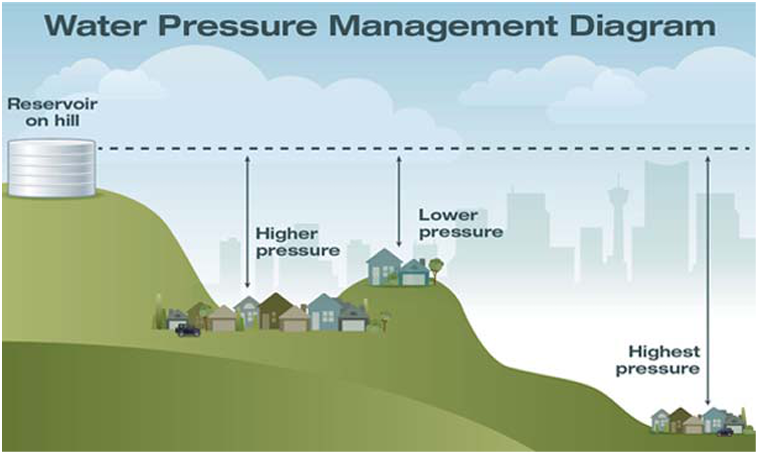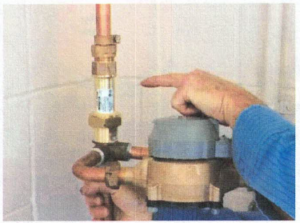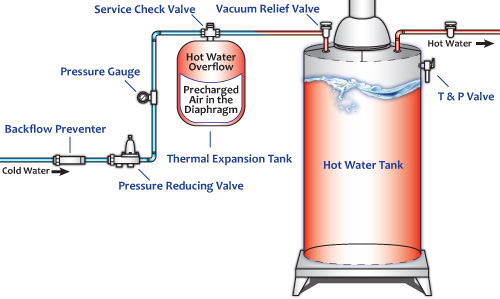
Serving the residents of Gray since 1929.
TOPICS: WATER PRESSURE – FLUSHING –
Water Pressure
We often get calls from customers regarding the water pressure in their homes. People want to know what the pressure is at their home, what is too much pressure, what is too little pressure, or whether the pressure in the water system changes. The purpose of this information page is to answer these frequently asked questions and to give homeowners the information they need to insure their plumbing performs and lasts as designed.
What is pressure and what is the water pressure at my home?
Water pressure is a measure of the force exerted on the water within a pipe, and is typically expressed in pounds per square inch or psi. Pressure in a public water system is nothing more than the difference in elevation between the Gray Water District’s water storage reservoirs and the elevation of the home where the water is being served.

Gray Water District’s pumps lift water from its wells to the storage tanks, through the distribution piping system. These tanks hold the water you use at your home and maintain the water pressure in the system. The maximum height of the water in the storage tanks is called the service or design elevation of the water system. All water systems are designed to provide the majority of their customers with good water pressure. When a system has different elevations in its service area, the pressure will be different depending on the elevation difference; the greater the difference, the greater the pressure.
The pressure at your home can be measured by using a pressure gauge or calculated mathematically. If you know the design elevation of the supply or source and the elevation at your home, you can calculate the pressure at your home. Gray Water District has two different design elevations in its service area, the Dry Mills area, and East Gray pressure zones. The design elevation of the Dry Mills pressure zone is 427 feet above sea level. The design elevation in the East Gray pressure zone is 452′ feet above sea level.
You can find your home’s elevation by either locating it on a USGS map, asking Siri on your smartphone, or online using Google Earth. Subtracting your elevation from the design elevation and dividing the amount by 2.31 (feet of elevation /1 pound per square inch) will give you the pressure in pounds per square inch (psi) at your location.
For example:
The elevation at the Gray Town Hall is 310 feet above sea level.
452 feet – 310 feet= 142 feet, 142 feet / 2.31 = 61.5 pounds per square inch or 61.5 psi
The elevation at the Dry Mills Fire Barn is 308 feet above sea level.
427 feet – 308 feet= 119 feet, 119 feet / 2.31 = 51.5 pounds per square inch or 51.5 psi
Pressure in the East Gray pressure zone varies from a high of 133 psi near sea level to a low of about 32.4 psi at the top of Yarmouth rd near our Weeks Hill Standpipe.
Pressure in the Dry Mills pressure zone varies from a high of 62.3 psi at Pine Cove to a low of 46.3 psi at the Gray middle school.
What is too much pressure, and what is too little pressure?
Water Utilities in the State of Maine are regulated by the Maine Public Utilities Commission (MPUC or PUC) and the State of Maine Drinking Water Program. The MPUC sets regulations regarding service standards, including pressure. These rules set a minimum pressure standard and do not set a maximum. MPUC rules set a minimum delivery pressure standard of 20 psi as measured at the connection to the water main. Connections below the 20 psi minimum can be made only under special agreements and these have to be individually reviewed and approved by the MPUC. The uniform plumbing code states that a home, where the pressure is expected to be in excess of 80 psi and has a check valve or backflow preventer at the service entrance of the home, and should have both a pressure regulator valve and a properly sized expansion tank on the cold water supply line. Pressure in excess of 80 psi can cause premature wear in the automatic solenoid-activated valves found in dishwashers or washing machines. These types of valves operate very quickly and may result in a water hammer noise or vibrations if pipes are not anchored securely.
As far as what is the “right” amount of pressure, we’ve found that this is very subjective. If a customer has lived on a private well (typically at 35 psi pressure) and moves to a home on a public water system, they will likely feel that the pressure is too high. Conversely, a customer moving from home at sea level in a public water system will find the pressure at a home on a well as being inadequate.
What is a check valve or back/low preventer and how do I know if I have one at my home?
A check valve is a one-way valve that is typically installed at the water meter of a home. The purpose of the check valve is to prevent water from flowing backward from the home back into the water system, therefore reducing the possibility of introducing contamination into the system. A backflow flow preventer is also a one-way valve that prevents a reversal of flow – It differs from a check valve (which is the simplest form of backflow preventer) in that it is a licensed device and it must be tested periodically to insure that it is working properly. These types of devices are used in situations where there may be a higher risk to the water system should a flow reversal occur. Some common applications for backflow preventers are irrigation systems, fire sprinkler systems, and any industrial setting.
You can check your meter setting (typically in the cellar) and look for the device, a typical meter setting is pictured below with the technician pointing to the check valve.

All water connections installed after 1972 are required to have a check valve as part of the meter installation. Older connections without check valves are upgraded to the new standard when the meter setting is changed or upgraded. Eventually, all connections will have some sort of backflow preventer.
Want to learn more about residential backflow prevention? Visit the Watts website for a great brochure on the subject at: http://www.watts.com/pages/literature_thumbs.asp?catld=65&pageld=157
What is Thermal Expansion?
Thermal expansion of water becomes a problem in homes when the plumbing system has a backflow preventer or check valve at the service entrance. Water expands when heated and the expansion of the water in a closed piping system results in an increase in pressure. These increases can be quite dramatic, and can result in relief valves releasing or hoses bursting. All boiler and hot water heater installations should include a properly sized expansion tank as part of the installation. These tanks give the expanded water a place to go as it heats, therefore maintaining pressure at safe levels in the system. The diagram below, courtesy of Watts Water Technologies Company, shows a proper installation with a pressure reducing valve at the service entrance and an expansion tank on the water heater feed line.

Control Thermal Expansion in Hot Water Supply Systems
Does the temperature -pressure relief valve on my boiler or hot water heater serve as a water pressure regulating device?
No, these are safety devices only. These valves are not designed for repeated uses and should not be expected to regulate pressure on an on-going basis. Manufacturers recommend that these valves be exercised on a semi-annual basis, something in our experience that rarely happens.
Does the pressure in the water system change?
Yes, but very minimally. The elevation of water in our tanks typically varies about 5 to 10 feet, which equates to a range of 2 to 5 psi. This small fluctuation is usually not an issue for most customers.
Why do my pipes rattle when the dishwasher stops or the washing machine changes cycles?
Noise from plumbing is usually associated with pipe movement or vibration. This can occur when piping is not secured properly with pipe hangers and brackets. The automatic valves in dishwashers and washing machines operate extremely fast and when the water stops abruptly in a pipe that can move it creates a noise or vibration. We call that phenomena “water hammer”, in extreme cases water hammer can lead to premature wear in plumbing and valves.
My garden hoses do not seem to last and they have actually burst on occasion, how come?
If you leave your garden hose filled with water after using it in the yard you may be witnessing thermal expansion at a local level. The water in our water mains is quite cool in comparison to the summer temperatures, typically ranging from 40 to 50 degrees. When you turn off the hose bib (outdoor faucet), you have created a closed system. When the sun heats the water in the hose it has to expand and this can result in a burst hose. If you have left the hose bib on with the hose off, you may still have a closed system as most new hose bibs have a backflow preventer incorporated in the design. If the hose bursts in this case if will flow until someone discovers the problem.
What Questions should I be asking my plumber when I have a service call?
What is the water pressure at my home?
Do I need a pressure reducing valve and an expansion tank?
Do I have a condensing boiler and does this require extra maintenance and have you been trained on this type of boiler and its maintenance?
Flushing
Why are water mains flushed?
The water mains are flushed to remove sediment and deposits from the pipes, which helps to maintain water clarity in the water distribution system. In addition to cleaning sediment from the water mains, the flushing program gives Gray Water District personnel an opportunity to operate and exercise valves and fire hydrants. If any problems are found during the flushing activities they are addressed to ensure that hydrants and valves are in good working order during an emergency.
In addition, water mains in your area may need to be flushed due to emergencies, water main breaks, and repairs, or water quality issues.
How are water mains flushed?
The flushing of water mains includes the systematic closing of various valves and opening of fire hydrants. This causes the rapid flow of water through the mains that carry out the sediment and deposits. We begin the process at the water tanks and transmission mains and work street by street, closing and opening valves to direct the flow of water.
How many days will my water be affected by flushing activities?
The water mains on your street will typically only be flushed once. However, while working in your neighborhood you may experience lower pressure at your premises during the flushing activities.
Will I still have water during the flushing activities?
In most cases you will still have water during the flushing of your street or neighborhood, however, you may temporarily experience lower water pressure. We recommend you refrain from using the water while we are flushing your street or area to avoid drawing sediment and discolored water into your plumbing. We also recommend that you avoid using your hot water; turn off automatic dishwashers, laundry machines, lawn sprinkler systems, etc. You may also want to turn off or bypass any water filtration or softening systems as well.
What should I do if I experience discolored water?
Avoid using hot water in your home to avoid pulling sediment, deposits, and discolored water into your water heater. After flushing activities have been completed in your area we recommend running the COLD water tap from a faucet located as close to the meter as possible (i.e., in the basement). Your water should clear in 10 to 15 minutes. If discolored water persists, please contact Gray Water District at 207-657-3500.
In addition, if you experience a “rusty” color staining to laundry after flushing activities have been completed please contact GWD.
How can I find out when the mains in my area will be flushed?
The water main flushing plan changes on a day-to-day basis due to unforeseen conditions the flushing crew encountered in the field (e.g., road construction, broken valves, inclement weather, etc.) and water-related emergencies. Based on the continuously changing field conditions, it is extremely difficult to determine exactly which streets or areas will be flushed more than a couple of days prior. However, GWD gives inquiring customers as much information regarding the flushing schedule as available at the time of the inquiry.
Change of Schedule:
The aggressive schedule could be delayed by inclement weather or an unforeseen emergency. Please check our website for flushing schedule updates.
There was emergency water maintenance work done in my area: What should I do afterward?
What to do after water is out due to maintenance work or a water main break. You may experience some cloudy, discolored, or spurting water. If you experience this, please run a cold water tap for 15-30 minutes to clear the issue. If this persists, call Gray Water District at 207-657-3500.
Discolored or rusty water: What should I do?
Customers experiencing dirty, discolored, or rusty water should run one cold water faucet for 10 to 15 minutes until the discolored water clears. *By not running the hot water initially, you’ll keep discolored water out of the hot water tank. We recommend you remove any screens, filters, or aerators on the faucet you are flushing before flushing. If you are unable to remove the screen, filter, or aerator you may try to flush the cold water tap in a bathtub. If the water does not start to clear after 10 to 15 minutes, please call Gray Water District at 207-657-3500.
Cloudy or milky water: What should I do?
Milky colored water is often caused by air in the water. Confirm this by filling a glass with water from the tap and checking for bubbles rising to the top. If you allow water in the glass to stand for a few minutes, the air should completely dissipate. To remove air from the line, run a cold water faucet at the highest location in the house for about 15 minutes.
Why is my water running slowly?
If the problem is only with one faucet, it may be a plugged faucet filter screen or aerator. Clean or replace the screen or aerator.
If more than one faucet has low pressure, check the following:
Shut-off Valve: Make sure the valve is open all the way.
Supply Line: If other houses in your area are experiencing the same problem, call Gray Water District at 207-657-3500.
Pressure Regulator or Pressure Reducing Valve (PRV): Your plumber can test, adjust, and/or replace the valve as needed.
Phone: 207-657-3500
Office Hours
Monday – Thursday
9:00 am to 12:30 pm
Service Hours
Monday – Thursday
8:00 am to 4:00 pm
Mailing Address
PO Box 196
Gray, Maine 04039
Payment Locations
Water District Office – In Person
Cash, check, or money order only
80 Shaker Road
Gray, Maine
Gray Shop ‘N Save – In Person
Cash, check, or money order
35 Portland Road
Gray, Maine
Credit cards or ACH payments accepted online